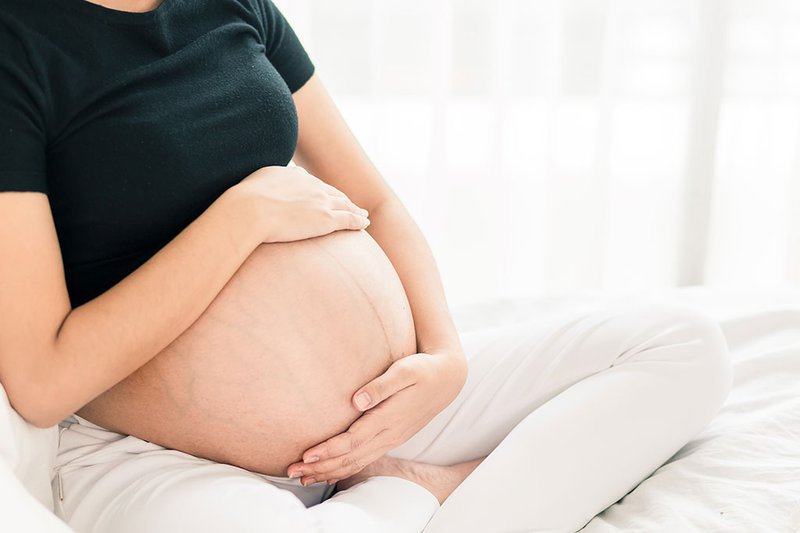Causes of uterine rupture during pregnancy
The article was professionally consulted by Specialist Doctor I Le Thi Phuong - Department of Obstetrics and Gynecology - Vinmec Ha Long International Hospital.
Uterine rupture is a serious, potentially fatal, pregnancy complication for the mother and fetus. This phenomenon occurs mainly due to ectopic pregnancy, labor, trauma, and implantation near the C-section.
1. What is uterine rupture?
Uterine rupture is a dangerous obstetric complication, potentially causing death for the mother and fetus. This phenomenon occurs during pregnancy, especially during labor.
Currently, many modern devices are applied to the medical profession, which has brought high efficiency in detecting ectopic pregnancy and threatened miscarriage cases that can cause uterine rupture. Thereby, limiting serious complications that occur due to not being diagnosed and treated in time.
Currently, many modern devices are applied to the medical profession, which has brought high efficiency in detecting ectopic pregnancy and threatened miscarriage cases that can cause uterine rupture. Thereby, limiting serious complications that occur due to not being diagnosed and treated in time.
2. Causes of uterine rupture
2.1 Ectopic pregnancy Ectopic pregnancy is one of the main causes of uterine rupture. When the size of the fetus grows, it will stretch the muscles at the implantation site such as the fallopian tubes, ovaries, abdomen, ... beyond the capacity of these organs, it will cause rupture. Because the structure of these organs is thin and not as resilient as the uterus, they are not a suitable environment for the implantation and development of the fetus. Over time, when the size of the fetus increases, it will cause uterine rupture. Therefore, early diagnosis and treatment of ectopic pregnancy helps to limit the risk of uterine rupture, which endangers the life of the pregnant woman.
2.2 Labor Labor is also a cause of uterine rupture. During labor, the uterus contracts strongly to push the fetus down and widen the cervix, preparing for the stage of childbirth. Increased contractility with the incorrect dose of oxidoxin is a major risk factor in labor risk. Because the drug can increase the stimulation of contractions, overstimulation can exceed the tolerance of the uterus causing uterine rupture.
2.2 Labor Labor is also a cause of uterine rupture. During labor, the uterus contracts strongly to push the fetus down and widen the cervix, preparing for the stage of childbirth. Increased contractility with the incorrect dose of oxidoxin is a major risk factor in labor risk. Because the drug can increase the stimulation of contractions, overstimulation can exceed the tolerance of the uterus causing uterine rupture.

Chuyển dạ cũng là nguyên nhân gây vỡ tử cung
2.3 Abdominal trauma Abdominal trauma when the fetus is small can cause miscarriage and miscarriage. However, when the size of the fetus is large, a strong trauma can put great pressure on the uterus, forcefully compressing and rupture the uterus in a moment. Therefore, women during pregnancy should pay attention to moving around at home, at work and when traveling by means of transport to avoid the unfortunate risk of happening.
2.4 Uterine rupture at the old incision Uterine rupture at the old incision is seen in women with a history of childbirth by cesarean section or who have performed other surgeries in the uterus. The old incision is the site of scar tissue, less elastic than other layers of normal muscle tissue, prone to cracking only when there is a strong impact. Therefore, the larger size of the fetus can cause excessive pressure on the uterine position at the old incision, causing tearing of the skin along the incision leading to uterine rupture. For cases where the implantation site is close to the old incision, there is a higher risk. Therefore, the ultrasound examination through periodic physical examination is an important job to help identify the abnormal position of the fetus and quickly handle the pregnancies near the old caesarean section.
2.4 Uterine rupture at the old incision Uterine rupture at the old incision is seen in women with a history of childbirth by cesarean section or who have performed other surgeries in the uterus. The old incision is the site of scar tissue, less elastic than other layers of normal muscle tissue, prone to cracking only when there is a strong impact. Therefore, the larger size of the fetus can cause excessive pressure on the uterine position at the old incision, causing tearing of the skin along the incision leading to uterine rupture. For cases where the implantation site is close to the old incision, there is a higher risk. Therefore, the ultrasound examination through periodic physical examination is an important job to help identify the abnormal position of the fetus and quickly handle the pregnancies near the old caesarean section.
3. Symptoms of uterine rupture
3.1 Uterine rupture during pregnancy Uterine rupture during pregnancy mainly occurs due to various causes such as ectopic pregnancy, trauma or pregnancy at the old incision. Typical symptoms of uterine rupture during pregnancy include:
Mild or severe shock due to blood loss There is a sharp pain when palpating the pelvic area Red bleeding Vagina Feeling the fetus in an abnormal position 3.2 Breaking uterus in labor Symptoms of threatened uterine rupture during labor include:
Maternal pain due to strong and continuous uterine contractions Vaginal examination shows signs of difficult labor (fetal disproportion- pelvis, abnormal position, tumor in the prostate) Fetal examination shows signs of fetal heart rate fast, slow or irregular. Over time, if not detected and handled promptly, symptoms will become severe and cause serious complications. More dangers such as:
Severe pain, sudden sharp pain that gradually subsides Signs of shock: Pale face, sweating, rapid pulse, low blood pressure and fainting Abdominal distension, pain Palpation palpation The baby is just under the skin of the abdomen The fetal heart is no longer working
Mild or severe shock due to blood loss There is a sharp pain when palpating the pelvic area Red bleeding Vagina Feeling the fetus in an abnormal position 3.2 Breaking uterus in labor Symptoms of threatened uterine rupture during labor include:
Maternal pain due to strong and continuous uterine contractions Vaginal examination shows signs of difficult labor (fetal disproportion- pelvis, abnormal position, tumor in the prostate) Fetal examination shows signs of fetal heart rate fast, slow or irregular. Over time, if not detected and handled promptly, symptoms will become severe and cause serious complications. More dangers such as:
Severe pain, sudden sharp pain that gradually subsides Signs of shock: Pale face, sweating, rapid pulse, low blood pressure and fainting Abdominal distension, pain Palpation palpation The baby is just under the skin of the abdomen The fetal heart is no longer working

Sản phụ đau nhiều do cơn co tử cung mạnh và liên tục là dấu hiệu dọa vỡ tử cung trong giai đoạn chuyển dạ
4. Treatment method
4.1 Threatening uterine rupture Establish an intravenous line for the patient Infuse 0.9% NaCl solution or Ringer Lactate solution Catheterize the pregnant woman Perform emergency caesarean section 4.2 Uterine rupture Actively resuscitate the patient disease, including:
Monitor vital signs:
Have patient lie down, incubate and breathe oxygen Compensate circulating volume by replacing isotonic solutions such as 0.9% NaCl, Ringer Lactate or blood transfusion and Gelafuldin and Heasteril solutions depending on the patient's condition. Inject high dose antibiotics Perform catheterization and monitor urine output Perform emergency caesarean section and manage the uterus:
Preserve the uterus in case of pregnant women < 40 years old, < 2 children, with fissures or simple uterine rupture and no signs of infection Total hysterectomy in patients with severe shock, infection, complicated uterine rupture, those who have given birth to 2 or more children.
Monitor vital signs:
Have patient lie down, incubate and breathe oxygen Compensate circulating volume by replacing isotonic solutions such as 0.9% NaCl, Ringer Lactate or blood transfusion and Gelafuldin and Heasteril solutions depending on the patient's condition. Inject high dose antibiotics Perform catheterization and monitor urine output Perform emergency caesarean section and manage the uterus:
Preserve the uterus in case of pregnant women < 40 years old, < 2 children, with fissures or simple uterine rupture and no signs of infection Total hysterectomy in patients with severe shock, infection, complicated uterine rupture, those who have given birth to 2 or more children.
5. Prevention of uterine rupture

Phát hiện sớm các trường hợp sinh khó và chỉ định mổ lấy thai trước giai đoạn chuyển dạ
Subjects with a higher risk of uterine rupture such as cesarean section, multiple births, fetal-pelvic disproportion. Close monitoring of contractions with obstetric monitors of pregnant women during labor Early detection of difficult births and indications for cesarean section before labor Use drugs to increase uterine contractions according to indications and doses Quality At Vinmec International General Hospital, there is a package maternity service as a solution to help pregnant women feel secure because of the companionship of the medical team throughout the pregnancy. When choosing Maternity Package, pregnant women can:
The pregnancy process is monitored by a team of qualified doctors Regular check-up, early detection of abnormalities Maternity package helps to facilitate the process. birthing process Newborns receive comprehensive care.
The pregnancy process is monitored by a team of qualified doctors Regular check-up, early detection of abnormalities Maternity package helps to facilitate the process. birthing process Newborns receive comprehensive care.
Để đặt lịch khám tại viện, Quý khách vui lòng bấm số HOTLINE hoặc đặt lịch trực tiếp TẠI ĐÂY. Tải và đặt lịch khám tự động trên ứng dụng MyVinmec để quản lý, theo dõi lịch và đặt hẹn mọi lúc mọi nơi ngay trên ứng dụng.
Bài viết này được viết cho người đọc tại Sài Gòn, Hà Nội, Hồ Chí Minh, Phú Quốc, Nha Trang, Hạ Long, Hải Phòng, Đà Nẵng.






